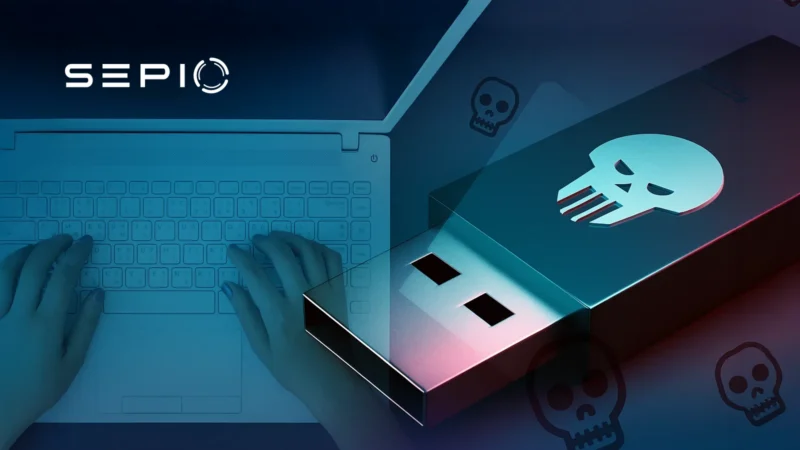USB Cyber Security refers to the measures and practices to secure and protect data and systems from threats and vulnerabilities posed by USB devices. USB devices has gained significant attention in recent years due to their widespread use in data transfer and storage, along with the associated USB Cyber Security risk. Malicious USB devices are specifically designed to attack when plugged into a computer or USB-enabled devices, introducing significant USB drive cyber security threats.
Why USB Security Management Matters
USB devices are used every day. They connect keyboards, mice, printers, storage drives, and more. While useful, they are also a way for attackers to get inside your systems.
Some cyber attacks start when an employee plugs in a harmful USB without knowing. This makes USB security management essential. It’s not just about software, it’s also about controlling physical access.
Real Threats from USB Devices
Attackers often use tricks to spread harmful USBs. One common method is handing out infected USBs covered up as gifts. When someone plugs the device in, it installs malware or records what you type. This can lead to data theft or even full system compromise.
These types of attacks have already happened. In one case, fake Amazon gift cards containing harmful USBs were mailed to U.S. companies. The goal? Trick someone to connect it and opening the door to the hacker.
Using Malicious USB Devices
USB Cyber Security has become critically important in light of rising threats like the Fin7 hacker attacks. The use of malicious USB devices poses serious USB Cyber Security risk to organizations and individuals alike. In early 2022, the FBI reported instances of hardware attack tools disguised as Amazon gift vouchers in USB thumb drive form sent to various US entities. These attacks exploit human emotions such as greed and fear, bypassing cautionary measures and underlining the importance of usb security management.
Like in the Amazon example, the FBI found that perpetrators were fraudulently impersonating the US Department of Health and Human Services (HSS) and sending packages containing malicious USB devices disguised as important COVID guidelines. Whether presented as a gift or containing vital information, the deceptive appearance of these devices often overrides caution. With a 30% increase in USB device usage in 2020, USB stick Cyber Security has become an increasingly significant concern.
Malicious USB Devices Impersonate Legitimate Devices
Now, you might think that even if an employee accidentally uses a Rogue Device, there are security measures to stop any successful social engineering attacks. Well, here is where the problem gets worse. Malicious USB devices act like legitimate devices. Not being noticed by existing cyber security solutions, such as EPS, EDR, XDR, DLP and IDS.
The lack of physical layer visibility means such solutions cannot identify the malicious USB device, instead recognizing it as the legitimate device it impersonates. By exploiting this blind spot, the rogue hardware is free to send keystrokes, execute malware and steal data, increasing USB Cyber Security risk.
For any organization, this is a significant USB drive cyber security threat. But for critical infrastructure entities, such as US defense contractors, the USB port cyber security risk becomes a matter of national security. In fact, such infrastructure is highly vulnerable to hardware based attacks, as Bad USB devices may be the only way into air gapped networks.
How to Detect Malicious USB Devices?
Employees remain highly prone to social engineering tactics, requiring enterprises to implement layered protection. However, most traditional tools fail to detect Bad USB and other rogue devices due to a lack of Layer 1 visibility, creating a massive gap in USB security management.

Sepio’s platform provides a panacea to gaps in device visibility. Ensuring you are getting the most out of your cyber security investments. Sepio integrates with existing solutions, such as NAC, EPS, SIEM and SOAR, to enhance enterprise usb security and USB Cyber Security capabilities.
Sepio’s deep visibility ensures that no device goes unmanaged. Its policy enforcement and Rogue Device Mitigation features automatically block not authorized or rogue hardware, including those posing USB Cyber Security risk. This enforces a Zero Trust Hardware Access (ZTHA) model and stops attacks at the first line of defense.
And while we can’t stop the appeal of an unexpected gift, we can stop the threats posed by malicious USB devices and protect your USB stick Cyber Security posture.
The Role of Sepio in Enhancing USB Cyber Security
As cyber threats, particularly Bad USB attacks, grow in stealth and complexity, the need for comprehensive USB security management solutions is more urgent than ever.
Sepio leads the charge in protecting IT, OT and IoT environments against increasingly complex USB Cyber Security threats. This complete approach helps organizations reduce USB drive cyber security threats and maintain resilience amid today’s sophisticated attack vectors.
See every known and shadow asset. Prioritize risks.
Talk to an expert. It will help you understand how to use Sepio’s patented technology to take control of your USB Cyber Security challenges.
Visit Sepio YouTube channel and view our Mission Possible – The Printer Hack video.






